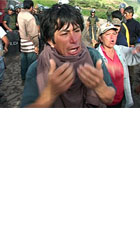
Choropampa: The Price of Gold 2002
Distributed by First Run/Icarus Films, 32 Court St., 21st Floor, Brooklyn, NY 11201; 800-876-1710
Produced by Ernesto Cabellos & Stephanie Boyd
Directed by Ernesto Cabellos & Stephanie Boyd
VHS, color, 75 min.
College - Adult
Latin American Studies, Environment, Human Rights
Date Entered: 12/30/2003
Reviewed by Susan Weber, Langara College, AEMAC, Vancouver, BCA mercury spill in June 2000 near the village of Choropampa, Peru results in a catastrophe for a small village. The Yanacocha mine, owned jointly by a Peruvian company and Newmont Mining of Colorado, with a small interest by the World Bank, sends their medical experts and engineers who insist the problem was quickly resolved and will not have long-term effects.
The residents, however, live with rashes, painful diseases and are not offered much sympathy or assistance by the mining company. They claim more than 900 people were poisoned, while the company claims 100 affected.
After two years of denial by the mining company, the new mayor leads his citizens in protests to gain attention and treatment.
The camera is able to be in the centre of this drama, attending meetings and being in the middle of the action, discussions and blockades. With hand-held camera action, the viewer can feel the tension and frustration of the citizens.
Interspersed with the personal stories of the spill and its cleanup, are the company experts, medical and technical, who are contradicting what the citizens are saying. TV footage of the news events, plus the mining company’s ad about the wonders of the mine and its clean-up from the spill all provide excellent contrast to see how innocent bystanders can be injured, ignored and dismissed as inconsequential. This film does not ignore that the government of Peru reaps the benefits of international mining interests, but does little for the people who suffer the poisoning. Peru has had a long history of riches which have been extracted, yet the population remains poor and exploited.
The film should have been edited to about half its length to be useful in the classroom, but will be an addition to academic collections of Latin American studies and globalization.